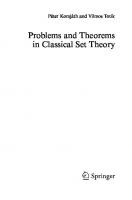Seven Theorems in the Problem of Plateau
386 91 464KB
English Pages 3 Year 1931
Recommend Papers
File loading please wait...
Citation preview
AIA THEMA TICS: J. DO UGLA S
VOL. 18, 1932
83
SE VEN THEOREMS IN THE PROBLEM OF PLA TEA U BY JESSE DOUGLAS DEPARTMENT OF MATHEMATICS, MASSACHUSETTS INSTITUTE OF TECHNOLOGY
Communicated November 24, 1931
The writer has recently completed the redaction of the manuscript of a paper presenting in complete form his results on the problem of Plateau for two contours; most of these results have been in my possession for some time past.' They are embodied in the form of seven theorems, which it is the purpose of this note to state. The complete paper will be published in the Journal of Mathematics and Physics of the Massachusetts I stitute of Technology. The two contours rF, r2 are Jordan curves in euclidean space, of n dimensions for theorems I, V, of two dimensions for theorem IV, and of three dimensions for theorems II, III, VI, VII. Always, rF and r2 are supposed not to intersect one another. With ri, r2 are associated three positive numbers, finite or + o: m
(rF),
m
(F2),
m
(rF, r2).
Concretely, these are, respectively, the least areas that can be bourded by rF, by r2, by ri acd r2;2 but for our analysis they are the lower bounds of certain functionals A (g1), A (g2), A (gi, g2; q), where gi, g2 are arbitrary parametric representations of ri, r2 and q is a parameter, 0 < q < 1. Always, there is the inequality
m(rF, r2) _ m(rl) + m(r2), e(rF, r2)
or
=
m(ri) + m(r2) - m(ri, r2)
> 0.
The functional of pairs of contours e(rF, r2) is defined by the last formula for the case of finite m(rF, r2). Whea m(ri, r2) = +c, we use the
functional:
e(rF, r2) *where rF, r2.
rF, rF,
=
lim sup
contours with finite
e(rl, r2) >- 0,
m(rF, rF),
(e.g., polygons), tend to
In theorems I, II, III, m(ri, r2) is supposed finite, while in theorems V, VI, VII the contours are arbitrary Jordan curves, generally with m(ri, r2) = +co-
MA THEMA TICS: J. DO UGLAS
84
PROC. I. A. S.
Minimal surface means one defined by the Weierstrass formulas: Xi = R Fi(w),
EFt2 (w)
=
i=1
O.
THEOREM I. Let rF, r2 be two Jordan curves not intersecting one another; let m(rl, r2) befinite, and suppose we have the strict inequality: or
m(rl, r2) < m(rl) + m(r2), e(ri, r2) > 0.
Then there exists a doubly-connected minimal surface bounded by rl, r2. The area of this surface is m(rl, r2). THEOREM II. Let rl, r2 be two Jordan curves not intersecting one another, and let m(rl, r2) befinite. If the minimal surfaces M1 and M2, determined by rF and r2 taken separately,3 have in common a point that is regularfor both of them (.1F(w) 12> then there exists a doubly-connected minimal surface bounded by rF and r2. The area of this surface is less than the sum of the areas of M, and M2. THEOREM III. Let rF and r2, Jordan curves withfinite m(rF, r2), interlace. Then rF, r2 are the boundaries of a doubly-connected minimal surface. The writer's theory of the problem of Plateau includes the conformnal mapping of plane regions as the special case n = 2. It is in this sense that the following theorem is to be understood. THEOREM IV. Let rl, r2 denote atty two Jordan curves in the plane which enclose between them a region R. In the equations Z
=
gl(Z), Z
=
g2(Z),
where Z and z denote complex variables, let Z describe rF, r2, respectively, when z describes two concentric circles C1, C2 of radii 1, q; 0 < q < 1. The range of values of the functional
A(gi, g2; q) =
4ap JCa ..Cp
g_E(z)
-
gd-) | 2 p(z, ; q)dz dD,4
i log -), when all parametric representations gi, g2 of rl, r2 and all values of q are considered, will consist exactly of all positive real numbers _ the inner area5 of the region R. This minimum value will be attained for a certain (essentially
(P(z, P; q) being a certain elliptic function with periods 27r, 2
VOL. 18, 1932
85
MA THEMA TICS: J. DOUGLAS
uniquely determined) parametric representation Z = g(z)Z =g(, together with a unique value q* of q. Then the integral formuka of Cauchy:
W1 tgl (z) dz 2
ici z-w-
I
fg2(z) dz 2-W
4
2ri c
> W of the circular ring between C1 and C2 into the region R between rT and r2; this conformal transformation, furthermore, attaches continuously to the topological correspondence g*, g2 between the boundaries. In theorems V, VI, VII the restriction of finite m(rl, r2) is removed from theorems I, II, III. THEOREM V. Any two Jordan curves rl, r2, not intersecting one another, for which ee(rF, r2) > 0, are the boundaries of a doubly-connected minimal surface. THEOREM VI. If rl, r2 are any two Jordan curves not intersecting one another, and the minimal surfaces M1 and M2 determined by rl and r2 separately3 have a regular point in common, then there exists a doubly-connected minimal surface bounded by rT, r2THEOREM VII. Any two interlacing Jordan curves are the boundaries of a doubly-connected minimal surface.
defines a conformal transformation w
I "A General Formulation of the Problem of Plateau," presented to the American Mathematical Society, Oct. 26, 1929, abstract in BuU. Am. Math. Soc., 36, 50 (1930). "The Problem of Plateau for Two Contours," communicated to the same society, Sept. 27, 1930, abstract in the same publication, 36, 797 (1930). 2 The surfaces bounded by F1 and r2 separately are supposed to be silnply-connected; those bounded by r,, r2 jointly, doubly-connected. 3 The existence of the minimal surfaces M1 and M2 is assured by the writer's paper "Solution of the Problem of Plateau," Trans. Amer. Math. Soc., 33, 1, 263-321 (Jan., 1931), which gave the first general solution of the Plateau problem for a single contour. 4 The sense of integration around C1, C2 is such that the circular ring between them is on the left. 5 The upper bound of the area of a ring-shaped polygon whose boundaries PI, P2 encircle rF and are encircled by rl; this is not always the same as the lower bound of the area of a ring-shaped polygon whose outer boundary PI encircles r1 and whose inner boundary Pa is encircled by r2 (outer area).
![The Plateau problem, Part 2. Present state of the theory [1 ed.]
2881247024, 9782881247026](https://ebin.pub/img/200x200/the-plateau-problem-part-2-present-state-of-the-theory-1nbsped-2881247024-9782881247026.jpg)
![The USSR Olympiad Problem Book: Selected Problems and Theorems of Elementary Mathematics [3 ed.]](https://ebin.pub/img/200x200/the-ussr-olympiad-problem-book-selected-problems-and-theorems-of-elementary-mathematics-3nbsped.jpg)








